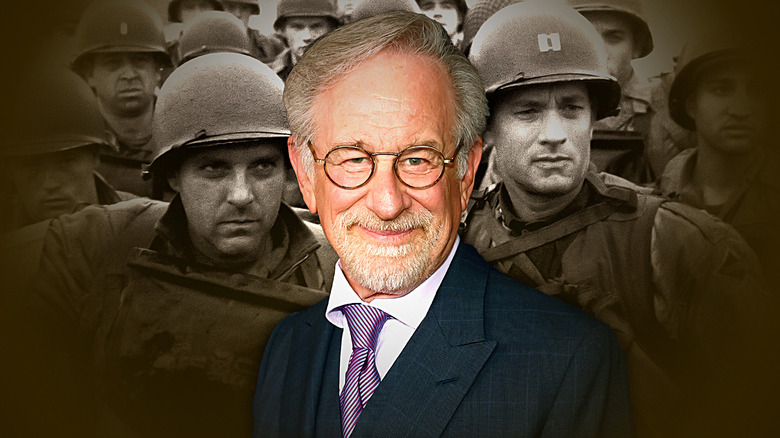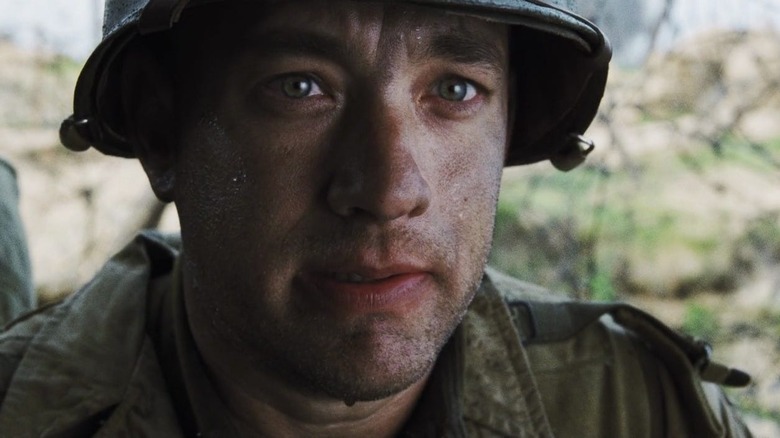Why Steven Spielberg Changed His Filmmaking Style For Saving Private Ryan
Does Steven Spielberg have a "style"? It's a question many who have studied Spielberg's work over the years have asked, with lots of folks proclaiming that Spielberg's style is kind of invisible. He tends to adapt himself to whatever story he's telling — the film dictates the style, in other words. Sure, he has his tricks he likes to employ (like the famous Spielberg Face, where characters look at something off-camera with awe), but the Spielberg style can more or less by summed up as "anything that's cinematic." As Pauline Kael once said, "If there is such a thing as a movie sense — and I think there is, Spielberg really has it." Spielberg is also very controlled — he's extremely precise as to where he puts the camera, and when.
That said, when it came time too helm his World War II epic "Saving Private Ryan," Spielberg decided to change things up a bit compared to his other films. He had dabbled in the WWII-era before, most notably with his Oscar-winning drama "Schindler's List," but with "Ryan," the filmmaker wanted to try some new approaches. While "Schindler's List" dealt with the horrors of the Holocaust, "Saving Private Ryan" is an on-the-ground war movie, loaded with scenes of brutal combat, including a stunning, unflinching opening sequence depicting the Normandy invasion.
As "American Cinematographer" pointed out when interviewing Spielberg in 1998 (via the book "Steven Spielberg" by Brent Notbohm), almost 90% of "Saving Private Ryan" was shot with handheld cameras, something different for a very controlled filmmaker like Spielberg. The handheld approach gives the movie a raw, rough feel — and as Spielberg confirmed, that was exactly the point.
Spielberg wanted Saving Private Ryan to be 'sloppy'
"The whole movie has a different style than anything I've done before," Spielberg told "American Cinematographer," adding:
"It's very hard and rough, and in the best sense, I think it's extraordinarily sloppy. But reality is sloppy—it's not the perfect dolly shot or crane move. We were attempting to put fear and chaos on film. If the lens got splattered with sand and blood, I didn't say, 'Oh my God, the shot's ruined; we have to do it over again' — we just used it in the picture. Our camera was affected in the same way that a combat cameraman's would be when an explosion or bullet hit happened nearby."
I don't know if "Saving Private Ryan" was the first movie to leave blood-splatter on the camera, but it's certainly one of the first times I ever noticed it happening in a movie, and it's fair to say it influenced filmmakers who made movies in the wake of "Ryan": countless modern action movies do the same thing to this day. In the same interview, Spielberg goes on to say that while this "sloppiness" was intentional, he still had plenty of control. "I could always do something over again if I didn't like it," the filmmaker said.
However, he also added that there was a lot of improvisation when it came to creating the movie's action sequences: "[I]n terms of my approach to the combat sequences, I was improvising all of them. I just went to war and did things the way I thought a combat cameraman would have." The results speak for themselves: "Saving Private Ryan" is often hailed as not only one of Spielberg's best movies, but one of the greatest war movies ever made. It also earned Spielberg a Best Director Academy Award

